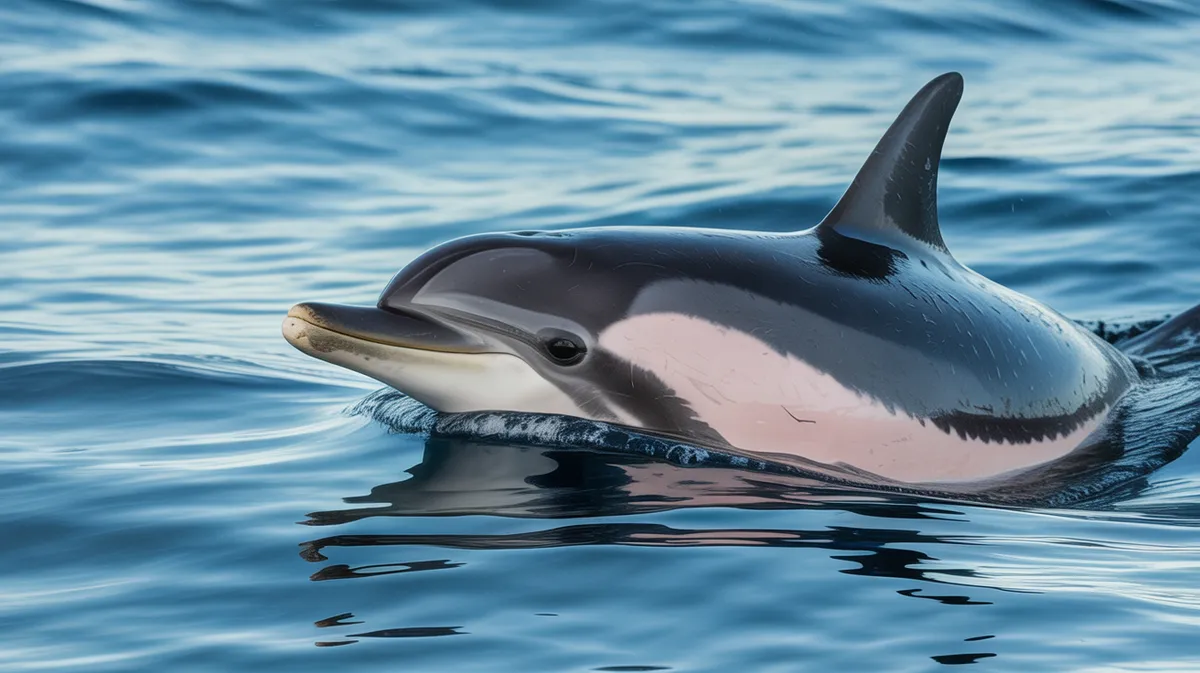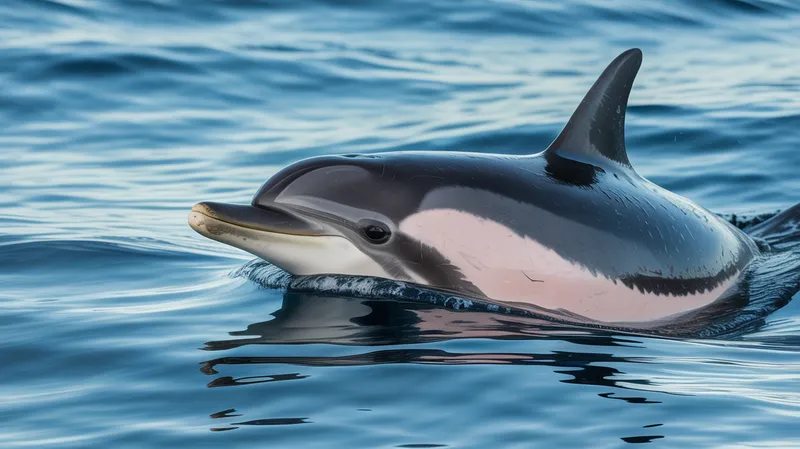
Dusky Dolphin
Lagenorhynchus obscurus

Meet the Dusky Dolphin
The dusky dolphin is a small, agile marine mammal known for its striking coloration and acrobatic displays. It has a robust body with a dark gray to black back, light gray flanks, and a distinctive white belly, often marked by a crescent-shaped patch behind the flipper. Dusky dolphins are highly social, living in groups that can number from a few individuals to several hundred, and are often seen leaping and spinning above the waves. They are native to the coastal waters of the Southern Hemisphere, especially around New Zealand, South America, and southern Africa, where they hunt cooperatively. Their intelligence and playful nature make them a favorite among wildlife observers.
Classification
Mammal
Habitat
Coastal ocean
Diet
Carnivore
Lifespan
20-25 years
Conservation
Least Concern
Weight
70-85 kg
📖Fascinating Facts
Acrobatic Swimmers
Dusky dolphins are famous for their high leaps, somersaults, and spins, often performing these aerial displays in groups.
Cooperative Hunters
They often work together to herd schools of fish or squid, using bubbles and synchronized movements to trap prey.
Southern Hemisphere Range
Dusky dolphins are found mainly in temperate waters of the Southern Hemisphere, with major populations off New Zealand, South America, and southern Africa.
📋Detailed Description
The dusky dolphin (Lagenorhynchus obscurus) is a small to medium-sized cetacean, typically measuring 1.6 to 2.0 meters in length and weighing between 70 and 85 kilograms, with males slightly larger than females. Its robust, hydrodynamic body is characterized by a short, well-defined beak and a tall, falcate dorsal fin positioned mid-back. The coloration is striking: the dorsal surface is dark gray to black, while the flanks are lighter gray, and the ventral side is white, often featuring a crescent-shaped patch behind each flipper and a white blaze running along the side. Dusky dolphins possess 27–36 pairs of sharp, conical teeth in each jaw, adapted for grasping slippery prey. Their pectoral flippers are moderately long and pointed, aiding in agile maneuvering. Highly social, dusky dolphins form dynamic groups ranging from small pods of 10–20 to superpods of several hundred or even thousands, especially in areas of abundant prey. They are renowned for their acrobatic displays, including high leaps, somersaults, and synchronized swimming. Communication is complex, involving a repertoire of clicks, whistles, and burst-pulse sounds. The species is distributed patchily in temperate to cool coastal waters of the Southern Hemisphere, with major populations off New Zealand, southern South America, southwestern Africa, and isolated oceanic islands. Their cooperative hunting strategies and intricate social bonds are considered among the most sophisticated in delphinids.
💡 Did you know?
Dusky dolphins can communicate using a wide variety of whistles, clicks, and body movements, and their societies have been studied for their remarkable cooperation and intelligence.
🔬Research & Sources
Wikipedia Summary
The dusky dolphin is a small oceanic dolphin found in coastal waters of the Southern Hemisphere. It is most closely related to the Pacific white-sided dolphin. The dolphin's range is patchy, major populations occurring around South America, southwestern Africa, New Zealand, and several oceanic islands, with some sightings around southern Australia. It has a somewhat stocky body with a short beak and a curved dorsal fin and flippers. Like its closest relative, the dusky dolphin has a multi-coloured pigmentation of black, grey, and white.
Last Modified: 5/30/2025
🎭Behavior & Social Structure
Dusky dolphins are diurnal and highly gregarious, exhibiting a fluid social structure with frequent fission-fusion dynamics. They often form mixed-age and mixed-sex groups, with some evidence of long-term associations among individuals. Foraging behavior is highly cooperative: dolphins herd schools of small fish such as anchovies, sardines, and mackerel into tight balls near the surface, then take turns feeding. This coordinated hunting may involve complex role differentiation, with some individuals driving prey while others feed. Dusky dolphins are also known to feed nocturnally on mesopelagic fish and squid, exploiting vertical migrations of prey. Social behaviors include mutual rubbing, synchronized leaping, and aerial displays, which may serve both communicative and social bonding functions. Rest periods are interspersed with active foraging and play, and dolphins may travel long distances in search of food. Interactions with other cetacean species, such as common dolphins, and occasional bow-riding of boats are also documented.
👶Reproduction & Life Cycle
Dusky dolphins exhibit seasonal breeding, with most calving occurring in spring and summer (October to February in the Southern Hemisphere). Mating is promiscuous, and courtship involves intricate displays, including synchronized swimming and physical contact. Females reach sexual maturity at 6–7 years, males at 5–8 years. Gestation lasts approximately 11–12 months, after which a single calf is born, measuring about 80–90 cm in length and weighing around 10 kg. Calves are nursed for up to 18 months, though they begin to sample solid food at a few months old. Maternal care is intensive, with mothers often accompanied by other adults (possibly alloparental care). Calving intervals are typically 2–3 years, depending on environmental conditions and maternal health.
🛡️Adaptations & Survival
Dusky dolphins are highly adapted for rapid, agile swimming, with a streamlined body, powerful flukes, and a large, curved dorsal fin for stability. Their short beak and conical teeth are specialized for grasping small, fast-moving prey. Echolocation is well-developed, enabling them to hunt in low-visibility conditions and at night. Social intelligence is a key adaptation, facilitating complex cooperative hunting and social learning. Their coloration provides countershading camouflage: a dark back blends with the ocean depths when viewed from above, while a white belly matches the brighter surface when seen from below. Behavioral flexibility allows them to exploit a wide range of prey and habitats, from coastal shallows to deeper offshore waters.
📚Research Sources
🎨Cultural Significance
Dusky dolphins hold significant value in ecotourism, particularly in New Zealand, where dolphin-watching tours contribute to local economies and raise conservation awareness. Their acrobatics and sociability have made them popular subjects in marine folklore and wildlife documentaries. In some indigenous cultures of South America, dolphins are featured in myths and stories, often symbolizing intelligence and playfulness. However, there is little evidence of traditional subsistence hunting in recent times.
🔬Recent Research & Discoveries
Recent research has focused on the social structure and communication of dusky dolphins, revealing complex vocalizations and evidence of cultural transmission of foraging techniques. Genetic studies have clarified population structure and connectivity, supporting the recognition of several subspecies (L. o. fitzroyi, L. o. obscurus, L. o. posidonia). Satellite tagging and photo-identification have improved understanding of movement patterns and site fidelity. Long-term studies in New Zealand and Argentina are monitoring population trends and the impacts of tourism and fisheries. Ongoing research is investigating the effects of environmental change on prey availability and dolphin health, including the accumulation of pollutants in tissues.
🎥Wildlife Videos

Dolphins off the Coast of New Zealand - Wild Dolphins - Full Nature Documentary
The different dolphin species living in the waters surrounding New Zealand have all evolved unique strategies to survive in their ...
Get.factual

Incredible Dolphin Moments | BBC Earth
Welcome to BBC EARTH! The world is an amazing place full of stories, beauty and natural wonder. Here you'll find 50 years worth ...
BBC Earth

Exploring the Secret Lives of Dolphins | 4K Nature Documentary
In this documentary, follow the extraordinary journey of biologist Angela Ziler and dolphin expert Michael Scherman as they study ...
Real Wild

Dusky Dolphins and Bull Sperm Whales | South Pacific | BBC Earth
Welcome to BBC EARTH! The world is an amazing place full of stories, beauty and natural wonder. Here you'll find 50 years worth ...
BBC Earth

The Incredible Life Of Dolphins | Changing Seas | Real Wild
Dr. Denise has dedicated her career to learning about how dolphins communicate, behave, and socialize in one area of the ...
Real Wild

LEGENDS OF THE RED DUST | Tsavo’s Predators Unleashed #naturedocumentaries | Wild Nature
LEGENDS OF THE RED DUST | Tsavo's Predators Unleashed #naturedocumentaries | Wild Nature Welcome to a wild and ...
WILD NATURE - Nature animal documentary
🌍Habitat Information
The Dusky Dolphin typically inhabits Coastal ocean environments. Dusky Dolphins have adapted to their environments with specialized features and behaviors.
Primary Habitat:
Coastal ocean
More detailed habitat information will be available soon.
🛡️Conservation Status
The Dusky Dolphin is currently classified as Least Concern. Conservation efforts are crucial for preserving this species for future generations.
Common Threats:
- 🏠Habitat loss and fragmentation
- 🌡️Climate change impacts
- 🎯Hunting and poaching
- 🏭Human-wildlife conflict
⚠️Threats & Conservation Challenges
Although currently listed as Least Concern by the IUCN, dusky dolphins face several anthropogenic threats. Bycatch in gillnets and trawl fisheries is a significant cause of mortality, particularly off South America and southern Africa. Habitat degradation, pollution (including heavy metals and persistent organic pollutants), and noise disturbance from vessels and industrial activities pose additional risks. In some regions, dolphins have historically been targeted in drive fisheries or for use as bait in crab fisheries. Climate change may alter prey distribution and abundance, potentially impacting population dynamics. Conservation challenges include limited population data in some areas and the need for international cooperation due to the species' wide, patchy distribution. Population trends are stable in some regions but declining in others, notably off Peru and Argentina.
🔬Scientific Classification
Scientific Name
Lagenorhynchus obscurus
Classification Hierarchy
🔍 About Taxonomic Classification
Taxonomic classification is a hierarchical system used by scientists to classify and organize living organisms based on shared characteristics and evolutionary relationships.
The system moves from broad categories (Kingdom) to increasingly specific ones, with each animal's scientific name typically consisting of its Genus and species.
📝Community Notes
Share your observations and insights about the Dusky Dolphin with our community of wildlife enthusiasts.
Join Our Community
Sign in to share your observations and connect with fellow wildlife enthusiasts.
Sign In to ContributeNo community notes yet
Be the first to share your observations about the Dusky Dolphin!
Explore Dusky Dolphin
Select a tab above to learn more about this amazing animal.
📸Photo Gallery
No photos available for this animal yet.
🌟Discover More Wildlife
Continue your journey of discovery with more fascinating animals from our database
